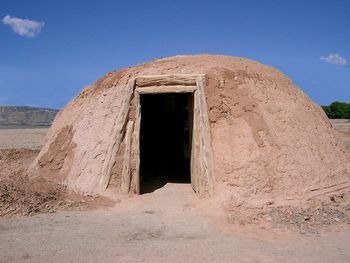Kinaalda
The Navajo or Diné is the largest Native American tribe (nation) in North America. According to the article published in Navajo Times on the 7th of July, 2011 there are 300,048 people who declare themselves as the Navajos. Larger Navajo communities exist in Arizona, New Mexico, Utah and California.
 Map of the Navajo nation
Map of the Navajo nation
They organize Kinaalda. What is it? It is a four day ceremony which includes girls who reached the puberty (first menstruation).
The origin of Kinaalda is in the ancient Navajo myth of the Changing woman. She was the first woman on earth who was able to have children. That is why it was possible for her to organize the first Kinaalda.
 Navajo hogan
Navajo hogan
The Kinaalda starts in a family hogan (hooghan in Navajo). The hogan is a traditional house of the American natives. Traditionally it has round and cone shape. But nowadays most hogans have square shape. It is important to say that the entrance to a hogan is always facing the east. It is done so as it is believed that the rising sun is good for the prosperity of those living in hogan.
Mother and daughter are sitting in a hogan. They sit facing the house door. Mother uses a traditional grass comb and a buckskin tie to comb out her daughter's hair and tie it into a ponytail. With this new hair style finished it is believed that the Kinalda has officially started.
Then the girl's family sings the first prayer. It lasts about 30 minutes. The girl wears a woven rug dress (made of traditional Navajo rug). She also wears some jewellery made of turquoise, shells and other materials. Finally she will put buckskin moccasins and wrap leggings around her calves. With all these "equipment" she is ready for something what is called the "race".
During this four days ceremony girl will run several times over the course. Usually she will run once in the morning and once in the evening. She will run to the east and back to her hogan.
Her fist night of Kinaalda will be very tough. It is true that she is going to spend the night in her hogan but she will not sleep. During whole night she will have to sit straight up with he legs in front of her. This night will be a busy one for the men of family too. They will sing several prayers.
The morning brings a new task. The girl will have to make an alkan (ceremonial corn cake). To make her task easier she will be able to use special stir sticks. These sticks are very important for the Navajo women as they are passed from generation to generation.
The "oven" in which the alkan is baked is actually a hole, about 122 centimetres wide and 30 centimetres deep. The girl has to dig out the hole. The men of the tribe will start the fire. When the dough is ready girl will cover the sides of hole with some corn husks. They should keep the cake to clean from ashes and other dirt. The cake will be baked during whole night.
The way the cake is being cut is rather unusual. It is cut from the east in circular direction. Everyone in the tribe gets little bit of the cake. The central parts of the cake are given to the most respectable members of the tribe like the girl's grandmother and the medicine man who actually organizes the Kinaalda.
In the next ceremony girl must perform the same tasks that have been performed on her. During the Kinaalda the girl will be "moulded" several times. What is "moulding"? It a symbolic process where the girl's mother will have the girl stand upright before her or lay her straight on the ground and pass her hands over the girl in a motion that is similar to that of moulding clay. The mother doesn't actually touch the girl, her hands float slightly above the girl's body. The girl's hair is taken down during this time and pulled out straight. The Navajo mothers do this for their daughters to grow strong and tall.
Later the girl has to repeat the same ritual on other members of the tribe who wish it. She will lift up smaller children hoping that they will grow tall and strong. She will also lay hands on the old and the sick. It is believed that during the Kinaalda she has power to heal.
The ceremony ends on the last day with a final run, a final moulding, and the distribution of the alkan.